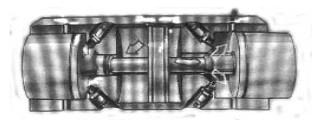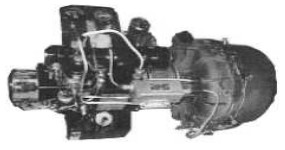Updated: 22-Aug-2024
Frank Stelzer made a strange engine to be tested initially in automotive applications but which according to its inventor is perfectly applicable to a helicopter.
-This last information gathered supports the theory that is questioned in Appendix 5 of this publication in which it is mentioned that the pistons drive electric generators at their ends.
-It seems to be true, doubting that they are rotary.
-The electric energy is what would move the wheels of the car or the rotor of the helicopter.
-It works with the two-stroke cycle.

“Schematic of the Stelzer engine”
-The shuttle-type piston train is clearly located on the right. It compresses the mixture in the left chamber, while the right piston has already discovered the exhaust port. There are two spark plugs per chamber.

“Stelzer engine”
-The carburetor and the two exhaust tubes are clearly visible.
From Appendix A5/6: This is not an aeronautical engine but it is based on the one that was (or intended to be). It was designed by Pescara around 1934. (Raúl Pateras Pescara).
-Made by Frank Stelzer, it was a free piston engine capable of generating 100 HP at 5000 rpm (?).
-The information contains several errors such as this one about the revolutions: if it is a free piston engine we are talking about alternations per minute.
-Another error is that a connection is specified at the end of one of the pistons to drive a generator or compressor. Therefore, if it has another mechanism connected, it is no longer a free piston engine.

“Stelzer, free pistons”

“Stelzer engine”
-Here we see the intake ports in the center and the exhaust ports in the middle of the cylinders. The logical thing is that the energy of the gases was used to drive a turbine and this one, yes, to drive a generator.
-The one shown is a prototype of 1231 cc. It was tested at the Western Technical University and presented at the Hannover Motor Show in 1981.
-The students who tested them reached 20,000 cycles per minute, with the possibility of going up to 30,000.
Engines of STELZER
Model: Double piston engine
Arquitecture:
Cooling:
Total Displacement:
Bore / Stroke: x
Power:
Weight:


